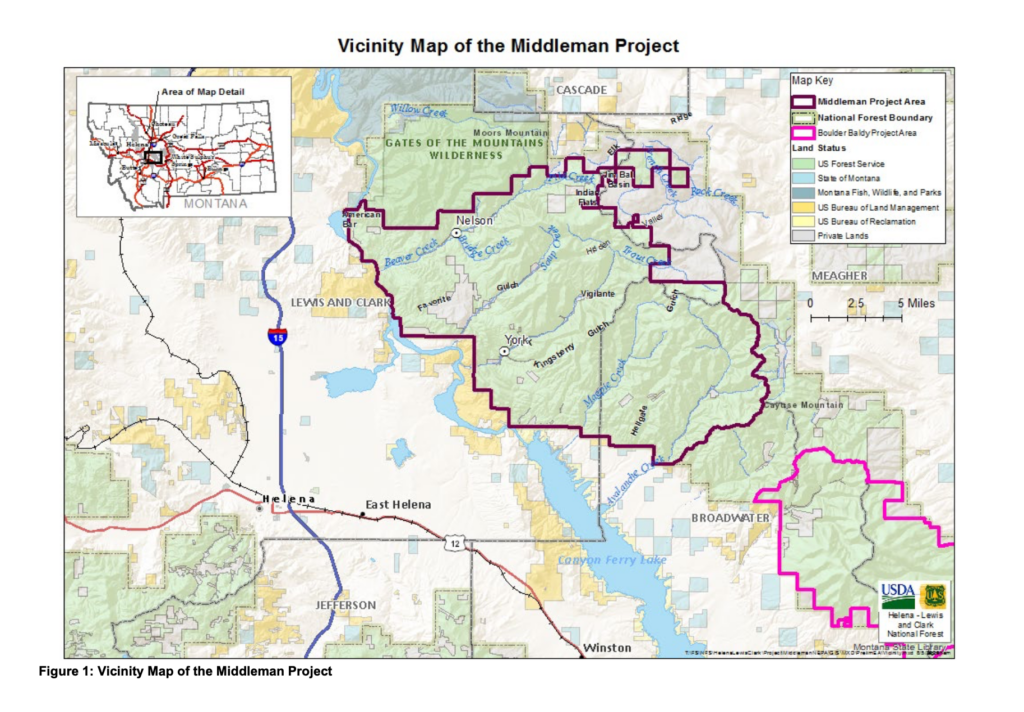Lost Potential: The Middleman Project And The Consequences Of Our Permitting Processes
"The Middleman Project is a textbook example of how our federal and state environmental permitting processes are broken and fuel litigation that harms our most critical projects, even those that will ultimately be good for our environment."
Key Points:
- Located in the Big Belt Mountain Range, the Middleman Project planned active forest management on 53,131 acres to mitigate wildfire risks, improve forest health, enhance wildlife habitats and reduce carbon emissions.
- Even after an extensive environmental analysis, two small fringe groups sued over the NEPA analysis in an attempt to stop the project.
- The subsequent litigation forced the Forest Service to make major cutbacks to the project’s scale, significantly limiting its environmental benefits.
Background
The Middleman Project is in the Big Belt Mountain Range, northeast of Helena within Lewis and Clark, Meagher and Broadwater counties.

According to the Forest Service’s Environmental Assessment, a substantial proportion of the Middleman Project area contains accumulations of hazardous fuels that “pose a risk to the communities of York and Nelson (including outlying developed subdivisions of El Dorado Heights and American Bar), as well as to public and firefighter safety in the event of a wildfire.”
The Forest Service also identified the risk of potential loss of habitat, threat to watershed quality, and even increased carbon emissions if existing conditions are continued:
“In the absence of prescribed fire to reduce stand density and fuel loads, the fire-adapted forest where the proposed treatments would take place may be more at risk to large and higher-severity wildfires (Agee and Skinner 2005, Stephens et al. 2013), resulting in decreased ecosystem services and potentially increased carbon emissions.”
The proposed Middleman Project would have addressed these risks via a combination of active forest management strategies, including logging and prescribed burns, conducted on 53,131 acres out of the total 141,799 acres included in the project.
The Forest Service noted many environmental benefits from the proposed project in its assessment, including:
- Reduced Risk of Catastrophic Fire:
- “improve conditions for public and firefighter safety in the event of a wildfire.”
- “promote vegetation conditions more resilient to the expected future role of fire and other natural disturbances.”
- “decreasing the risk of stand-replacing fire and in favor of low- and mixed-severity fire”
- Improved Forest Health:
- “Resiliency of individual stands as well as the landscape to natural disturbances is expected to improve”
- “hazard to bark beetles and western spruce budworm would be reduced”
- “The resiliency of old growth stands would be improved”
- Improved Wildlife Habitat:
- “the removal of conifers from grasslands, shrublands, and forest understories would increase foraging options for elk.”
- “this would result in an increase in local habitat diversity and forage productivity which is expected to benefit mule deer.”
- Reduced Carbon Emissions:
- “help to support forest health in a changing climate and reduce greenhouse gas emissions over the long term.”
Ultimately, the Environmental Assessment for the Middleman Project totaled 584 pages and the project took over a year and a half from scoping to assessment to decision.
In its Environmental Assessment, the Forest Service determined the Middleman Project “will not significantly affect the quality of the human environment, nor will it significantly impact any resource areas,” meaning that it did not require preparation of an even lengthier Environmental Impact Statement.
The project was approved for implementation on July 1st, 2021.
Lawsuit
Over two years after approval, two small fringe groups sued to stop the project, claiming it violated federal law and in particular the National Environmental Policy Act (NEPA). The litigants focused on the adequacy and detail of the Environmental Assessment.
An op-ed from Mike Garrity, Executive Director of one of the plaintiff groups, breaks down their litany of concerns about the Environmental Assessment:
- “Failed to even disclose the concerns voiced by the Montana Department of Fish, Wildlife and Parks due to too many roads and the loss of forest hiding and thermal cover.”
- “the environmental assessment for this project does not disclose the known location of recent illegal motorized use”
- “failed to analyze the effects and cumulative effects of that illegal motorized use on elk and grizzly bears.”
- “failed to include an accurate cumulative effects analysis of logging and roading on all lands — regardless of ownership — on grizzly bears”
- Remapped Lynx habitat “without any public process or environmental effects analysis, which is illegal.”
Ultimately, the litigants reveal they deny the science of active forest management, despite the Environmental Assessment extensively detailing wide scientific consensus that active forest management helps mitigate the threat of catastrophic wildfires and protects critical habitat for wildlife like elk, lynx and grizzlies:
“Not only does the Middleman Project violate numerous federal laws and harm endangered and native species, it won’t prevent wildfire as the agency contends,” said Garrity.
The Impact
Instead of a lengthy court battle over the adequacy of the environmental analysis, in April 2024 the Forest Service agreed to a settlement in which it made huge concessions to reduce the scale of the Middleman Project, forgoing almost all of the planned timber harvest and temporary road construction.
The Forest Service also agreed to substantially scale back planned prescribed burns, limiting burns to “no more than 25%” of the area, and provide an annual summary to the litigants of prescribed burning activities.
As part of the settlement, court documents also indicate the Forest Service will end up paying the litigant’s attorneys $39,000 in fees.
Conclusion
While the Middleman Project can now move forward, its potential to improve forest health and wildlife habitat, reduce carbon emissions and mitigate the risk of catastrophic wildfire will be severely diminished due to NEPA-related lawsuits. Over 550 pages of scientific analysis and over a year and a half of meticulous review was not adequate enough to stop radical litigants who deny the science of forest management from trying to shut down this project.
The Middleman Project is a textbook example of how our federal and state environmental permitting processes are broken and fuel litigation that harms our most critical projects, even those that will ultimately be good for our environment.
